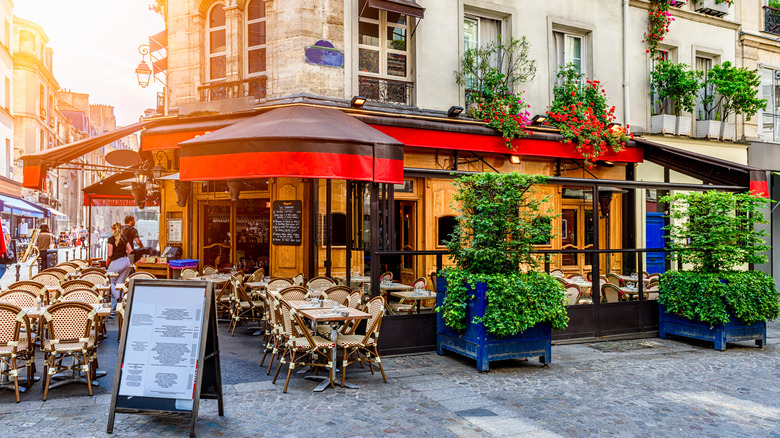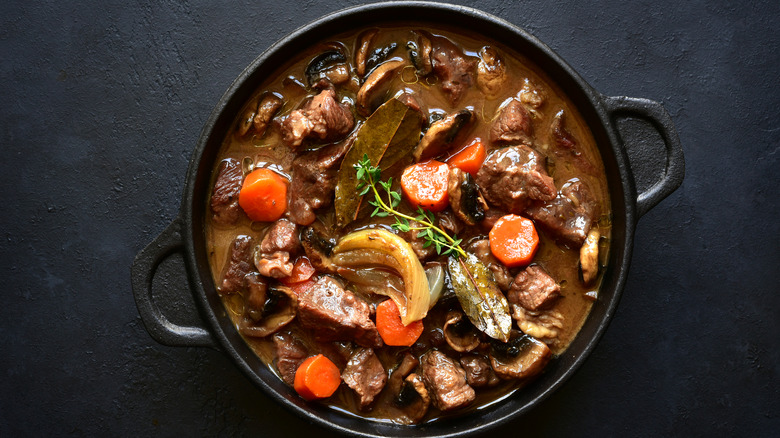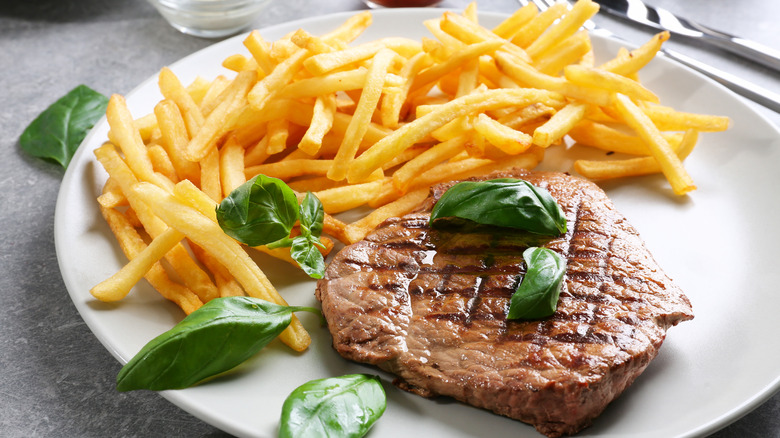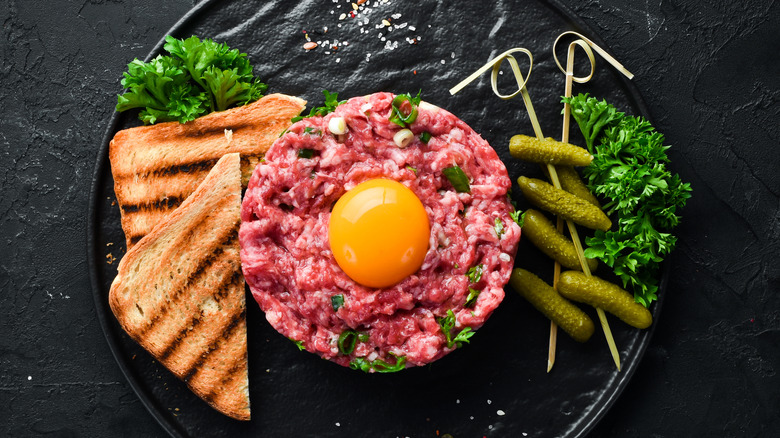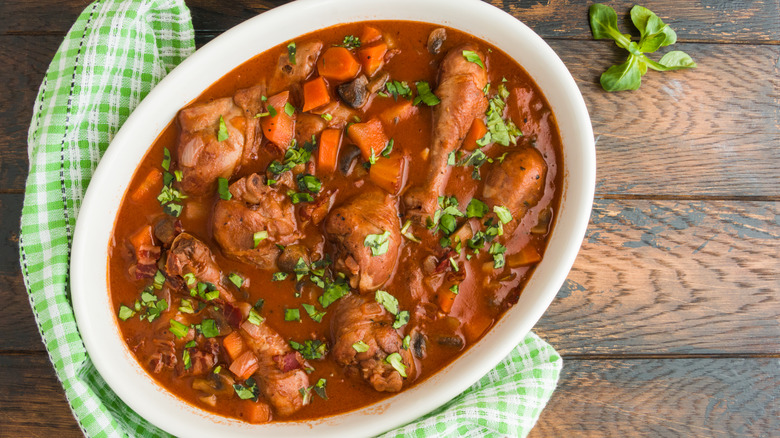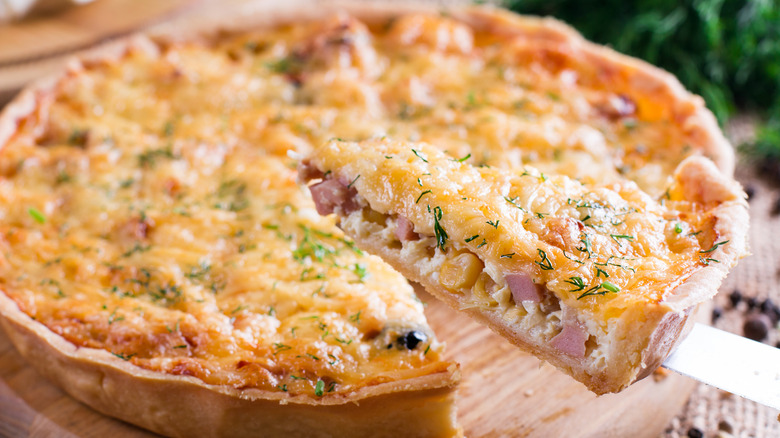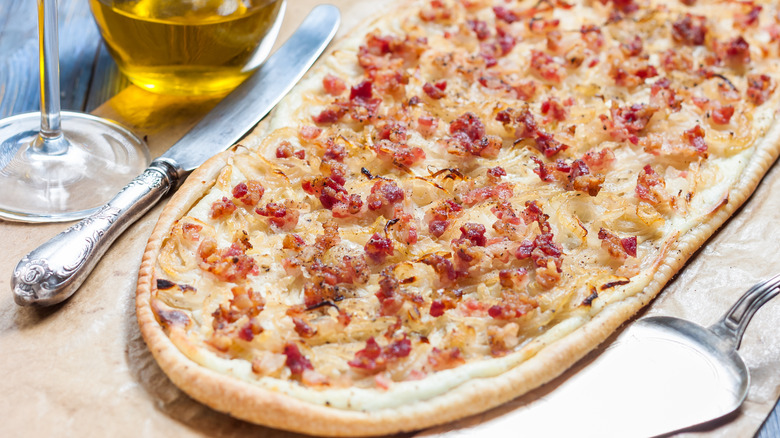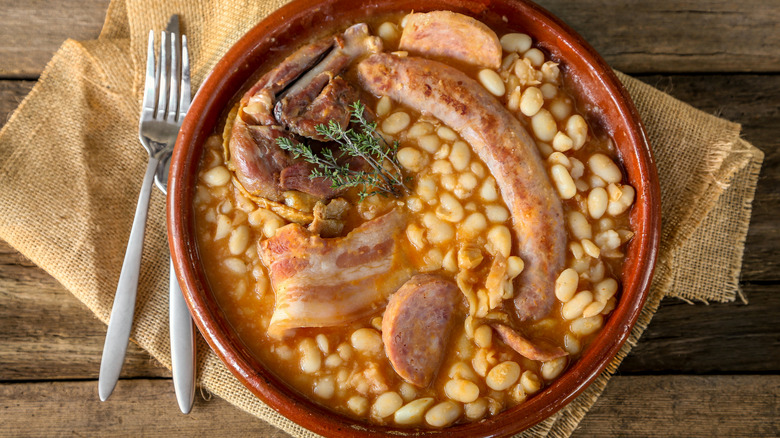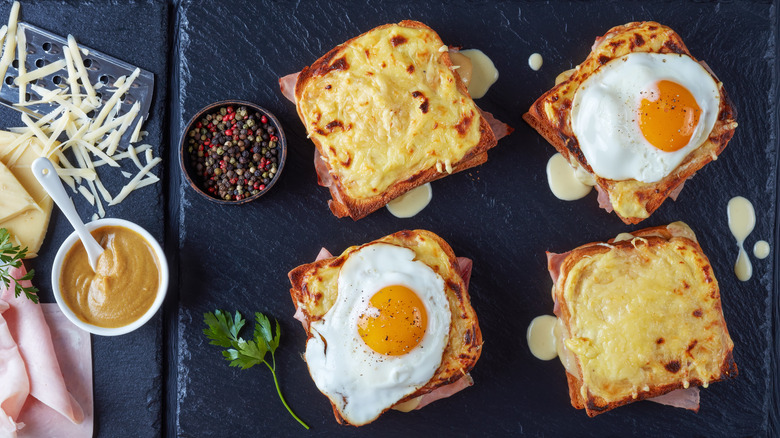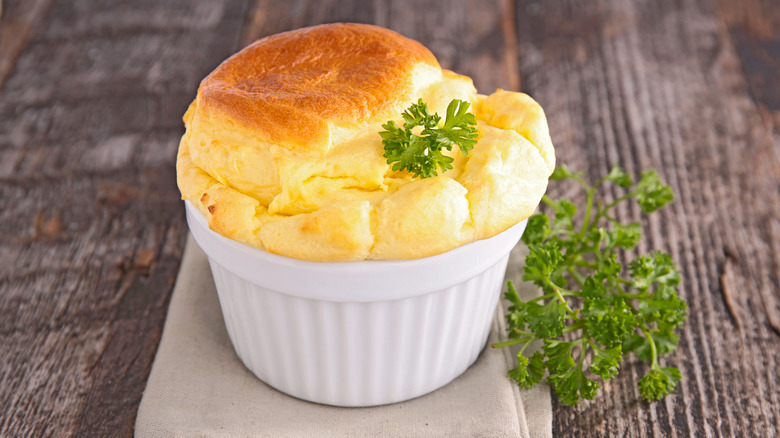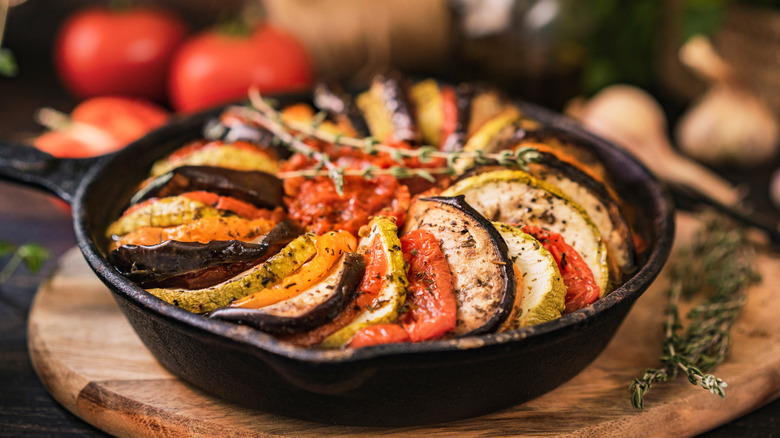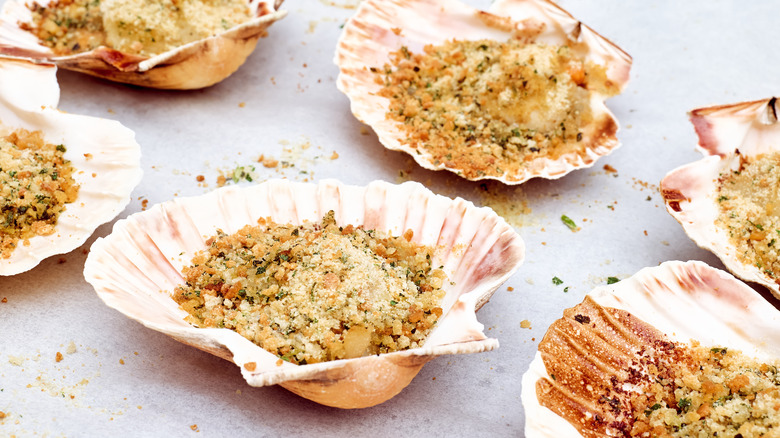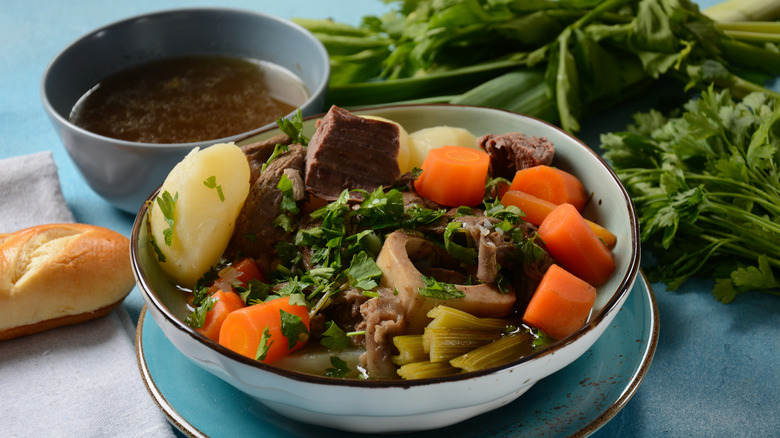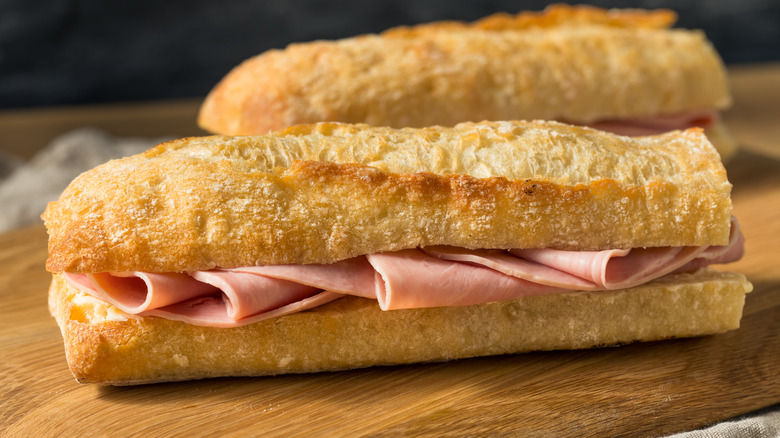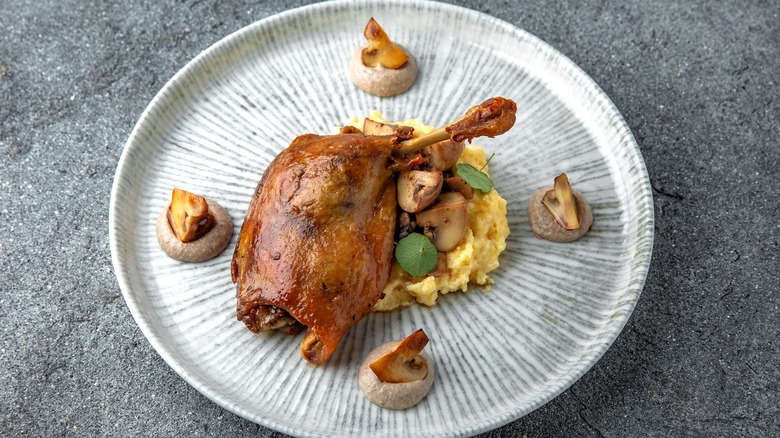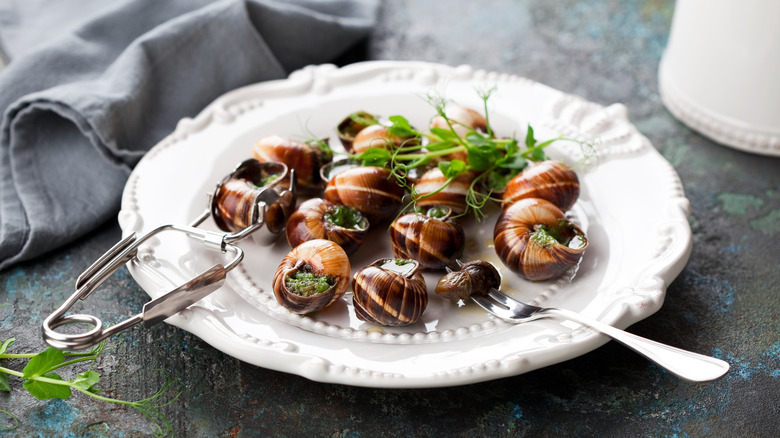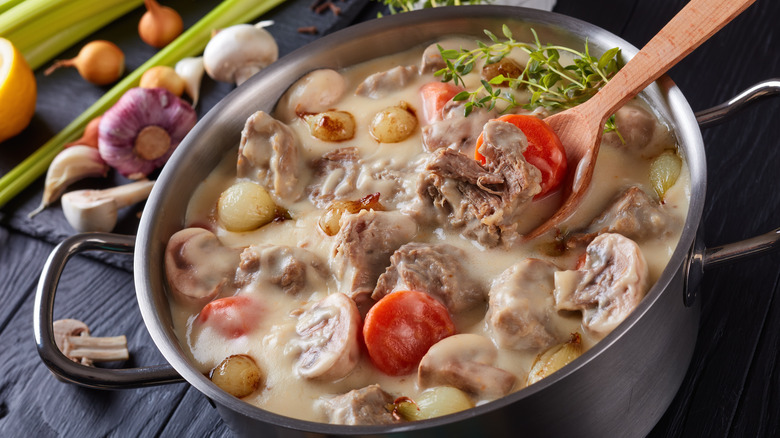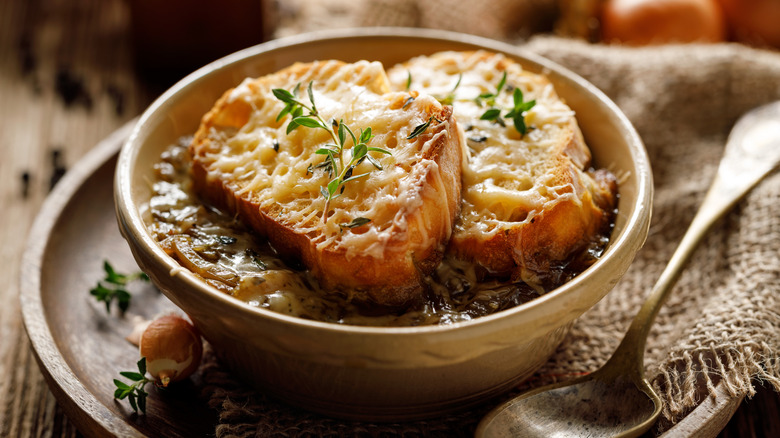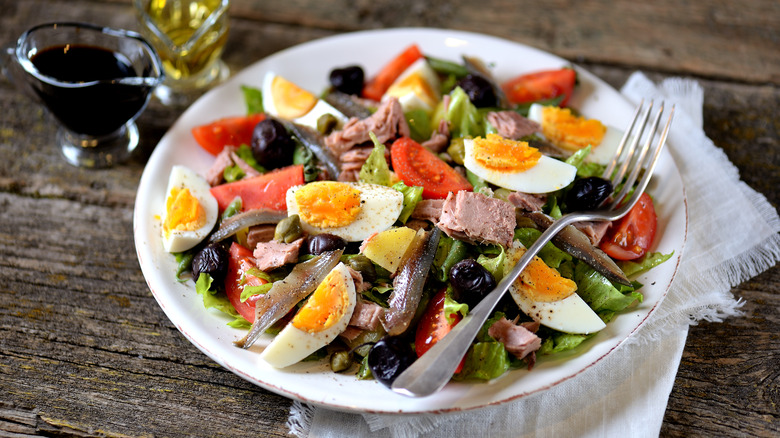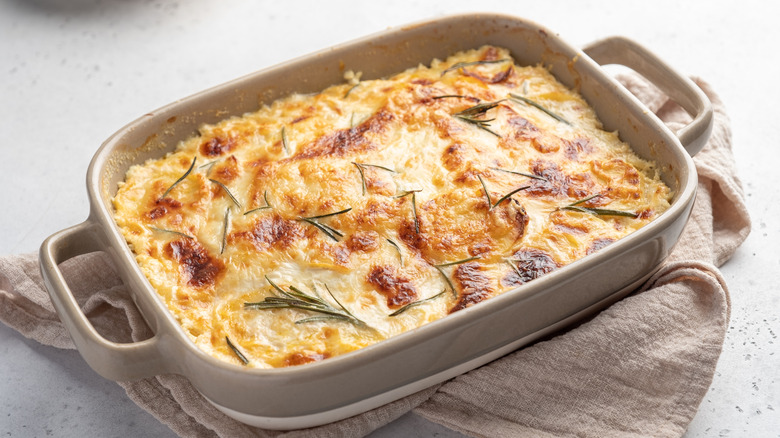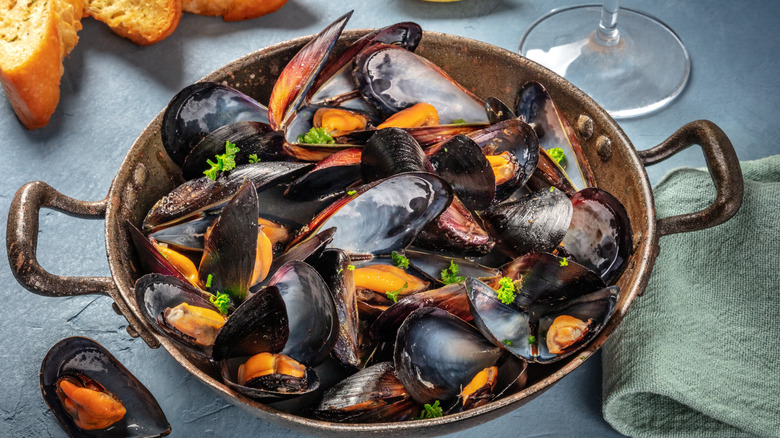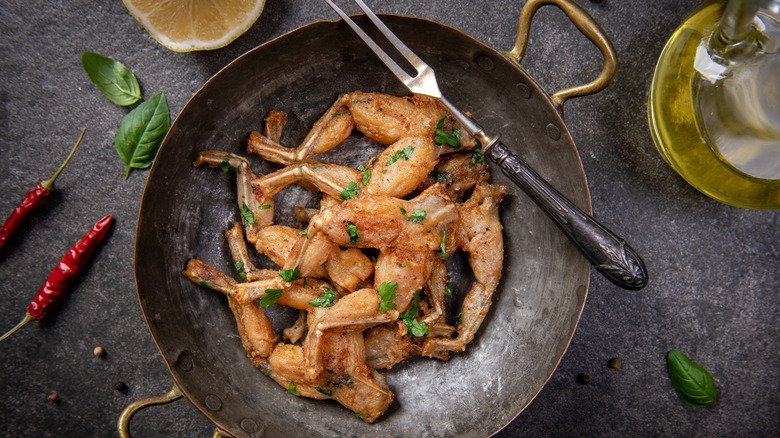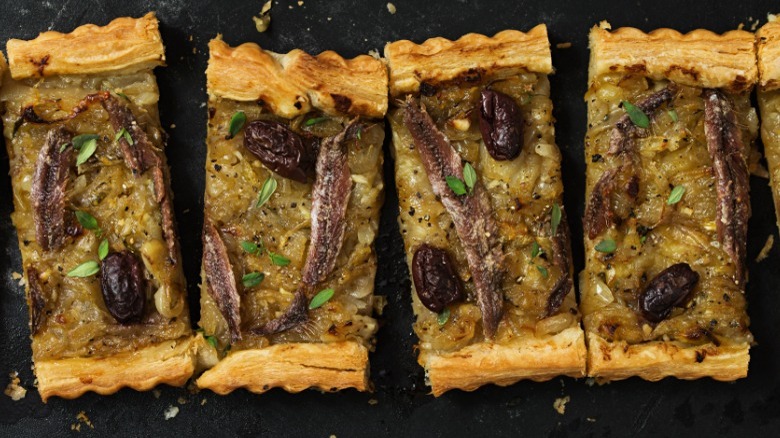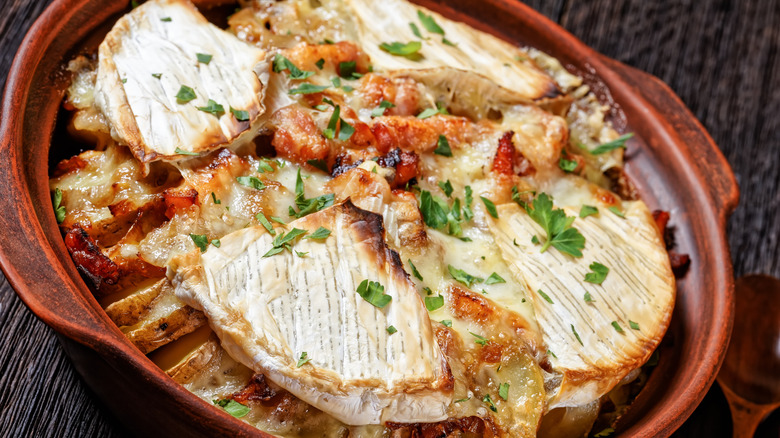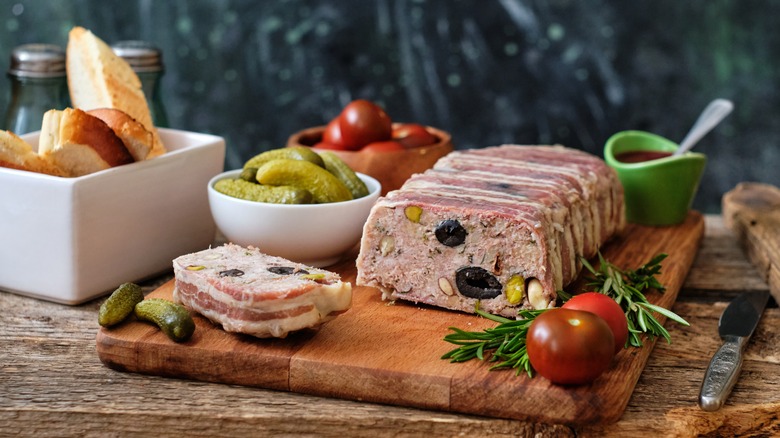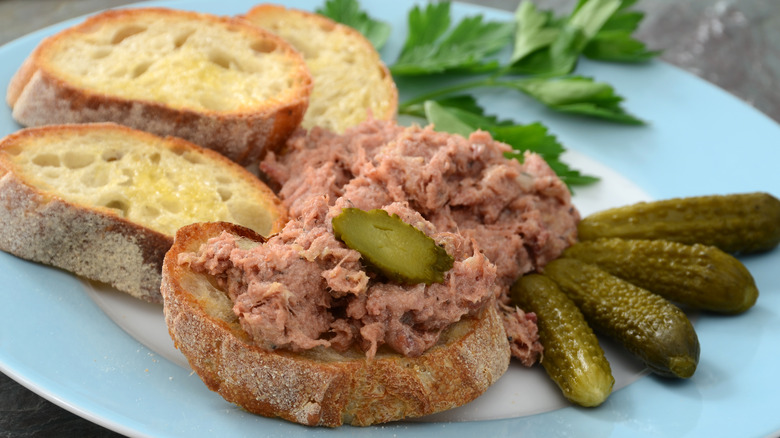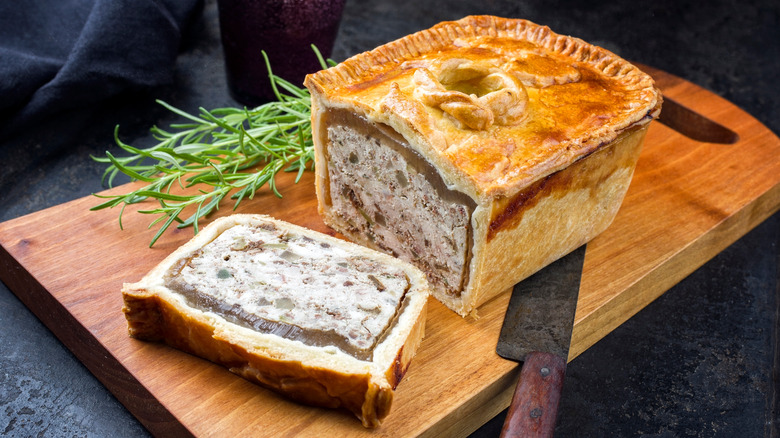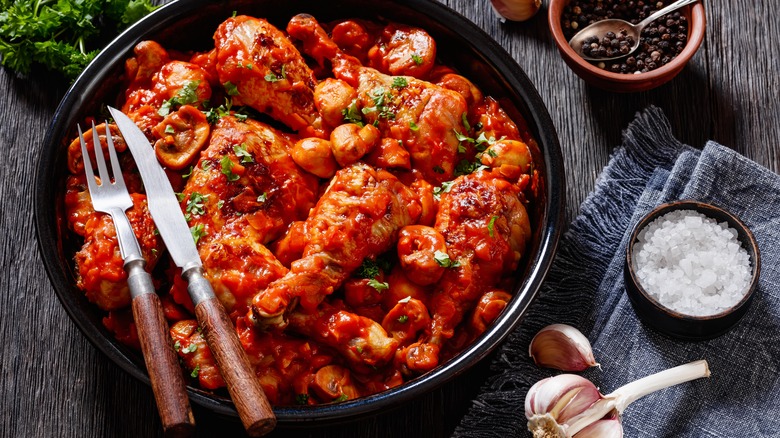29 French Dishes You Need To Try At Least Once
Taste is certainly a subjective matter, and what titillates one person's palate may land flat for another. Nevertheless, identifying techniques and dishes from world cuisines that have influenced and inspired the culinary landscape can shed some light on the evolution of food. While it's fair to say that every country shares its local specialties with pride, the French take it a step further. The Escoffier School of Culinary Arts, founded by famed French chef Auguste Escoffier, highlights the importance of French cuisine internationally, going so far as to say that "[it] has come to rule the world." While it might sound arrogant, as the French colonized regions across the globe, they also spread their food traditions.
A few elements lie at the heart of French cuisine, according to Escoffier: technique, fresh seasonal ingredients, and attention to the details of the overall dining experience. In fact, UNESCO recognized the French gastronomic meal as an intangible cultural heritage of humanity. The ritualistic nature of the classic French dining experience is steeped in tradition, yet there are many components that are relevant in the modern day, such as the mere concept of a restaurant, which is credited to the French.
Apart from the cooking techniques and dining customs, French cuisine shines with its reliance on simple, high-quality ingredients and methods to consistently create a satisfying meal that will nourish you inside and out. Vegetarians be forewarned: French meals typically favor meat.
Boeuf bourguignon
As far as warm nourishing stews go, boeuf bourguignon — a beef dish from Burgundy — is high on the list. It's no secret that the comforting meal is a favorite, and a 2017 survey found that it was considered by a majority to be France's national dish. The stew dates back to the Middle Ages, once prepared as a resourceful method to tenderize cheap pieces of meat. Although the preparation can be traced back much further, Auguste Escoffier was the first person to document a recipe at the start of the 20th century. Escoffier's version used a large hunk of meat, and it was actually American chef Julia Child who first used cubed beef in her iconic recipe.
There are many ways to prepare the dish, and it continues to be transformed by chefs worldwide. Generally, the meat is first browned before being slowly braised in the local pinot noir wine. It's not uncommon to cook the stew for a day or two, and the consensus is that it tastes even better the following day. The other components of beef bourguignon are simple and can include onions, garlic, thyme, carrots, potatoes, mushrooms, and herbs.
Steak frites
Simplicity doesn't get much better than a plate of steak frites — unless you're ordering it in a bustling Parisian bistro. While steak and fries might sound boring to some, proper execution takes it to the next level. The dish is typical in France and Belgium, where it is classically accompanied by a pint of beer or glass of wine as an easy bistro dinner.
The steak tends to be a flank or hanger steak, cheaper cuts often left behind at butcher shops in favor of filets and sirloins. Describing his first experience with the steak, Anthony Bourdain wrote in The New York Times, "What's good — what's great — about French cuisine stems from its guiding principles, and no principle is more firmly ingrained in the minds and souls of French-trained chefs than the idea that one must 'use everything.' Use what's available. Use it to its best effect ... every scrap of shank, shoulder, and jowl."
The only decision you need to make is how you want your steak cooked — skip well-done if you want to be served in Paris. Pan-fried or grilled, the meat is served up simply with the chef's choice of sauce. There's no ketchup to be seen here, and béarnaise or hollandaise are commonly served alongside instead. Depending on the preparation, cooked shallots or onions might also top the steak. As for the fries, they range from thick-cut to crispy matchsticks, perfect to pop into your mouth between bites of steak.
Steak tartare
While it's not yet a mainstay on American menus, steak tartare is a common offering in France. Curiously, the raw beef preparation was originally called Steak à l'Américaine, and tartar was only included in the name when it was served with tartar sauce. Rest assured that the preparation is made with high-quality meat (though stick to consuming it at reputable locations). We're not talking about ground burger meat; instead, the steak is finely chopped with a sharp knife, though it can quickly appear to be minced.
The meat is combined with an assortment of seasonings, including classics such as Dijon mustard, capers, egg yolk, onion, parsley, pickles, Worcestershire sauce, Tabasco, salt, and freshly cracked black pepper.
Occasionally, steak tartare is served with a raw egg yolk in its center. You'll often find crostini or toasted bread to scoop the meat, and crispy fries or a fresh salad are welcome pairings if it is served as a main meal. Alternatively, a simple appetizer of steak tartare and crostini is a light way to start a meal. Thanks to the balanced combination of seasonings, you'll easily forget you're eating raw meat and simply enjoy every flavorful bite.
Bouillabaisse
Although many of France's cities are found inland, the coast has its fair share of activity as well. Of course, the outcome is an assortment of seafood-based specialties, and this Provençal icon is no exception. The bustling port of Marseille is the home of bouillabaisse, a seafood-heavy stew that was popularized by local fishermen coming in with their catch. What was once prepared as a spicy soup to flavor leftover fish scraps has since evolved into a dish of high caliber, central to the Provençal cuisine.
Mediterranean fish is at the heart of the stew, including such prime options as John Dory, monkfish, and red snapper. Buffa goes on to list other ingredients that go into the dish, including potatoes, tomatoes, onion, garlic, fennel, and saffron. The soupy preparation is served with crunchy slices of bread seasoned with aioli or rouille (a sauce made with red pepper, garlic, egg yolk, bread crumbs, and fish stock). As with many traditional dishes, varieties in preparation abound, and bouillabaisse can be served as a one-pot meal or in two parts: the spicy soup with bread, followed by fish cooked and presented in the soup as a second course.
Coq au vin
Another iconic stew from Burgundy, coq au vin consists of a rooster slowly cooked in a wine sauce. Much like with beef bourguignon, the wine (typically red but white can be used) helps tenderize the tough meat to make it appetizing. The rooster is cut into pieces and stewed in a pot with wine, onion, carrots, celery, garlic, mushrooms, and seasonings such as thyme, bay leaves, salt, and pepper. Some recipes add bacon for a savory flavor that makes this dish extra tempting.
In the traditional recipe, the sauce is thickened with rooster's blood near the end of the cooking process, typically accompanied by brandy and vinegar to prevent the blood from clotting. These days, however, it is more common to use flour and butter as thickening agents. And since not every city dweller can get their hands on a fresh rooster, chicken makes a good substitute and also minimizes the cooking time.
Since coq au vin develops a rich sauce, it is best served with starchy sides to mop it up. Try it with mashed or boiled potatoes, noodles, or even a crusty loaf of bread. The peasant origins of this dish are clear from the use of rooster; however, its exact records are hard to trace. But once again, American chef Julia Child popularized coq au vin with her own recipe.
Quiche Lorraine
A few staple ingredients are behind quiche Lorraine, an egg-based dish from France's Alsace region. Historically, the area has alternated between German and French control, and this dish actually originates from a 16th-century German preparation. In fact, the word quiche comes from the German word kuchen, meaning cake.
Not quite a cake but more akin to a pie, quiche Lorraine begins with either a shortcrust or a puff pastry base. The shell is filled with a rich cream and egg custard, seasoned with smoked pork lardons and nutmeg. Regional variations exist, and cheese or onions are sometimes incorporated into the filling. When the perfect consistency is achieved, the silky custard practically melts in your mouth, pleasantly contrasted by the flaky buttery crust. Quiche Lorraine is a nourishing meal that's ideal in the winter months, simply served with a green salad.
Tarte flambée
Yet another dish from the German-French region of Alsace, tarte flambée, or flammekueche, shares its origins with both countries. The dish is like an Alsatian pizza, noting that it has been prepared regionally since the 13th century, a common staple among peasants stretching extra dough into a tasty meal. The thin crust is spread with cream, and onions and smoked pork bits are sprinkled across the surface. The whole is briefly popped into a piping hot oven and typically enjoyed communally from a wooden board.
While most recipes stay true to the original from centuries before, modern establishments include some creative twists. Extra cheese, vegetables, and even sweet variations can be found. Although it's fairly simple to make, tarte flambée is rarely prepared in homes, instead favored in a local eatery after a long day outdoors. Since the dough is extremely thin, you can easily enjoy a few squares of flammekueche as a shared appetizer before your main meal.
Cassoulet
French cuisine has no shortage of hearty stews, and cassoulet from the southwest of France is another fine example. The name of the dish comes from a cassole, a type of ceramic dish designed for cooking at high heat. The recipe is said to have originally been prepared as sustenance for soldiers fighting against the English army in the 14th century. Indeed, goose or duck, vegetables, and beans cooked in the oven undoubtedly provide plenty of nourishment, but there's no need to be a soldier to enjoy it.
The recipe is vague, favoring local ingredients — which means that the dish will be slightly different depending on where you have it. Among the meats you might find, The Connexion lists duck confit, pork shoulder, sausage, and mutton, and the variety of beans also differs regionally, though they are generally white. Typical seasoning vegetables such as carrots, onion, and garlic are included in the slow-cooked dish. While you might not crave cassoulet in the middle of the summer, it is like a warm hug on a cold winter night.
Croque Monsieur and Croque Madame
These two classic sandwiches have a masculine and feminine title, though they're both up for grabs for anyone with an appetite and are easy to find at any Parisian bar or café. A Croque Monsieur elevates the standard sandwich experience, thanks to a few key elements, and as with so many timeless dishes, there are variations to the recipe.
Plain white bread is usually favored, either coated in butter or with a béchamel sauce. Next, sliced ham and cheese (it had better be Gruyère!) are layered on the bread. Typically, the sandwich is grilled in the oven for a few minutes or pan-fried in a skillet until the cheese melts. Then, it is topped with more béchamel sauce and grilled a bit longer until the sauce is bubbling and golden. However, some people skip the béchamel topping or mix it in with the cheese instead.
As for a Croque Madame, the same sandwich is topped with an egg that is poached or cooked sunny- side up, making it a filling meal in itself. If you're looking for a slightly lighter take, both can be made open-faced.
Cheese soufflé
Although the technique is an obstacle for many budding chefs, a well-made soufflé will change your life (perhaps not quite, but the experience is unlike any other). The airy preparation dates back to the 1700s, although the recipe was only documented in the following century. While a great soufflé evokes utter satisfaction, the risk of it deflating once it is removed from the oven is high — hence the importance of careful attention to detail and technique.
Although they can be made with many ingredients, a cheese soufflé is the perfect savory dish. Apart from cheese (traditionally Comté is favored), whisked egg whites, butter, milk, and flour as the main ingredients. Ham is sometimes added for an extra salty touch. As the ingredients bake, the concoction puffs up in a light and airy shape, reminiscent of a cloud. MasterClass explains that the characteristics of a soufflé result from whisking the egg whites, a method that creates air bubbles that eventually expand with heat. Once you've tried a cheese soufflé, you had better rush to taste a chocolate soufflé.
Ratatouille
Not only was "Ratatouille" the name of a 2007 blockbuster hit, but it's also an iconic dish from the south of France. It's perfect for using up summer garden vegetables, as eggplant, tomatoes, peppers, zucchini, and fresh herbs all shine front and center. Culinary historian Alex Benvenuto tells BBC that what defines a ratatouille is pan-fried vegetables finished off in a garlic, onion, and tomato sauce. Although the dish is irrefutably French, Benvenuto points out that none of the fundamental ingredients of the meal originate in France, but made their way over from America or India in past centuries.
Of course, it's never so simple with classic dishes and variations abound. Some versions consist of uniformly cubed vegetables, whereas others opt for sliced discs or half-moons. Unlike the one-pot meal some might consider it to be, a proper ratatouille entails cooking each vegetable separately before completing them in tomato sauce. Regardless, the final product should not be watery or soupy; instead, you should end up with a rich, layered stew brimming with seasonal flavors.
Coquilles Saint-Jacques
Most simply, coquilles Saint-Jacques is the French name for scallops; however, for those in the know, it also means a delicious gratin preparation. The origin of the saint's association with scallops is a matter of legend, and plenty of tales seek to explain it. The gist of it is that when the tomb of Saint Jacques (aka Saint James) was found on the coast of Spain, a cathedral was built and pilgrims flocked to visit, following the Camino de Santiago trail along the way. The nearby waters were filled with scallops in their shells, leading them to be named after the famous saint.
Legends aside, if you order coquilles Saint-Jacques in a French restaurant (ideally in France!) expect to be served scallops on the half shell. Cooking methods vary depending on whom you ask, and poaching, frying, and grilling are among them. Some preparations require the scallop to be chopped up and cooked before being transferred back to the shell, while others keep it whole. The meat is covered in sauce, which can be simply made with cream or with white wine, onions, and shallots. Finally, a sprinkling of cheese or buttery breadcrumbs and a parsley garnish are added on top and the scallops are grilled until golden. Enjoy coquilles Saint-Jacques as a starter before your main course, paired with a glass of rosé for the ultimate match.
Pot-au-feu
France's selection of nourishing stews is certainly notable, and pot-au-feu is one among many. Translated into English, the dish's name means pot in the fire, which hints at the origins of its preparation. Although the stew was initially enjoyed by peasants, it eventually became popular with a range of classes and is now one of France's national dishes. Surprisingly, throughout the centuries, the slow-cooked stew was at the heart of controversies of social class, finally rising above as a dish for all.
The ingredients are straightforward, but the result is undeniably comforting and perfect for cold weather. At the onset, pot-au-feu was a simple (and warming) way to feed a crowd; consequently, its contents were based on availability. The meat could easily be pork, chicken, or beef, and root vegetables were often favored. Nowadays, the dish is typically made with beef; the marrow is included to thicken the consistency. Traditionally, the meat and vegetables were added to a ceramic pot and kept over the fire throughout the day; however, a stockpot on the stove will work if you're making it at home. Three meals can come from pot-au-feu: meat and vegetables, soup, and marrow on toast. Not bad for a one-pot meal!
Jambon beurre
It doesn't get much simpler — or classically Parisian — than a jambon beurre. The three-ingredient sandwich is, in fact, often named le Parisien after the city in which it was created in the 19th century. A generous chunk of baguette is sliced in half, spread thick with butter, and topped with wet-cured Paris ham. As a quick and nourishing lunch that could be prepared with no fuss, the sandwich was initially common among the working class.
These features and its easy yet delicious combination elevated the jambon beurre's popularity with the wider public. These days, more than one billion sandwiches are sold yearly, making it the most popular snack of its kind. Nevertheless, such high numbers mean that attention to quality is a key indicator in making a memorable jambon beurre. Artisanal baguettes and ham are prized, cultured butter is a must, and sandwiches made on the spot are favored for freshness. Finally, when you bite into it, the baguette should have a pleasant crunch that easily gives way to the salty, creamy flavors within.
Confit de canard
Duck confit is surely one of France's top gourmet dishes. Although the preparation is traditionally from Gascony in the southwest, it has quickly become popular all over. The confit technique was originally intended as a form of preservation, but nowadays the meal shines on its own. Nonetheless, you can still purchase fully preserved cooked duck in jars of duck fat, ready to be added to a stew. It's delicious in cassoulet.
Similar to chicken but with a higher fat content, duck meat is slow cooked in its own fat, creating a decadent melt-in-your-mouth texture and a rich flavor. The confit process entails seasoning the meat (thyme, bay leaves, shallots, garlic, salt, and pepper are common) before letting it cook at a low temperature in a ceramic baking dish for multiple hours. Puy lentils are a typical pairing to complement the savory poultry, often served as a bed for the meat.
Escargots
We can't speak about French cuisine without mentioning snails. The Burgundian specialty has been a staple for thousands of years. The delicacy fluctuated in popularity over the millennia, but it has certainly endured the test of time. In fact, the preferred regional species of snails is protected and can only be harvested during a strict period to ensure repopulation. Due to its rarity, NPR reports that a majority of the snails consumed in France actually come from other countries in Central Europe.
In any case, snails aren't necessarily an everyday meal and are instead often enjoyed as part of festivities. Traditionally, the creatures (minus the shells) are cooked in a broth before being popped back into their shells, seasoned with garlic, parsley, and always plenty of butter, and baked. While it might require you to step outside of your shell, escargots are a culinary treat and French icon. You had better like garlic, though.
Blanquette de veau
The name of this traditional dish hints at its preparation. Blanquette entails cooking ingredients in a white sauce with seasonings. Unlike other dishes that require the meat to be browned, here, veal is essentially boiled in a broth that is then thickened with cream, egg yolks, or a roux. The final result is a rich, creamy stew that's brimming with chunks of meat and the addition of mushrooms and onions. This slow-cooking method favors cheap cuts of meat, which benefit from the long process. Hence, blanquette de veau is an affordable way to feed a crowd.
Although the first recorded recipe dates back to the 18th century, an indication that the dish was served long before is clear. It's not hard to see why this creamy preparation continues to be popular around France, as its simple nature and classic flavors are timeless. Blanquette de veau is typically served with rice to soak up the rich sauce, but other starchy sides like pasta and potatoes are equally welcome.
French onion soup
This timeless classic has certainly made its way to the United States, and it's not hard to find French onion soup on menus in restaurants of all stripes. Although the soup has evolved over time, the current rendition has been prepared since the 17th century. While it might seem like a ubiquitous menu item, the soup's popularity was only cemented in the mid-20th century.
The dish consists of a simple onion and meat broth topped with a crusty piece of bread that's covered with grated cheese, typically Comté or Gruyère, and finished off in the oven. It's hard to think of anything as satisfying as golden, bubbling cheese melted over bread that's sitting in an oniony broth. If you're looking for a hangover cure (or at least a way to hide behind onion breath), French onion soup was once a common solution.
Salade niçoise
Named after the city of Nice in the south of France, this refreshing salad is both a feast for the eyes and taste buds. Depending on the version, salade Niçoise is nourishing enough to be a proper meal. The main ingredients are tomatoes, anchovies, capers, black olives, capers, and broad beans, simply seasoned with olive oil, lemon, garlic, and fresh herbs. Of course, most people are more familiar with one of the various twists that include lettuce, radishes, artichoke, tuna, hardboiled eggs, or potatoes.
As always, what's permissible depends on who's preparing the salad; in fact, many people will argue that cooked vegetables are off-limits. Indeed, the purpose of the Provençal dish is to highlight the fresh flavors of seasonal produce. As for the fish, traditionally either anchovies or tuna were used, but nowadays both are often served in the salad. Seared tuna might seem like the gourmet version, but canned tuna filets in olive oil really shine here.
Gratin Dauphinois
What's not to love about creamy potatoes? Although the preparation is simple, gratin Dauphinois is sure to hit the spot every time. The dish originates from the Dauphine region in southeast France, but it has since become a French classic with regional variations. The rich preparation can be served either as a comforting meal or as a side with meat.
Thin potato slices, butter, and cream are spread out in a baking dish and cooked until the spuds are ready and the top is a deep golden color. Some garlic, nutmeg, salt, and pepper can be included to season. While you might be inclined to add cheese, it isn't necessary. As the cream bakes in the oven, the edges brown into a crusty finish.
Famed cookbook writer Elizabeth David writes in the Daily Mail that the authentic version omits eggs or cheese — plenty of cream does the job. That said, if you add cheese the dish will still be considered acceptable, depending on whom you ask. In fact, The Guardian indicates that the Larousse Gastronomique (a prized encyclopedia of cuisine) allows for some grated Gruyère.
Moules marinières
If you're a fan of mollusks, there's no simpler way to savor them in their natural splendor than by ordering a heaping plate of moules marinières. Translated as sailor-style mussels, the delicacy can be traced back several hundred years. The story goes that a shipwrecked Irish sailor survived by harvesting mussels hanging on bird nets, leading future sailors to enjoy the simple preparation, too. Typically cooked with basic ingredients on hand, this seafood dish is evidence that a little goes a long way.
A base consisting of butter, shallots, garlic, and thyme is the foundation of the flavor. The mussels are added to the mixture and steamed in white wine. The tasty dish is usually garnished with fresh parsley and served with toasted baguette bread — you'll want to soak up all the extra broth in the bowl. Inspired by the Belgian dish, another common pairing you're likely to find in brasseries in the north of France is moules-frites or mussels with fries. Take this briny meal up a notch by enjoying it on a patio overlooking the sea.
Sole meunière
A simple fish recipe might not seem like it has what it takes to become an iconic dish, but then again, sole meunière is one of a kind. Revered by Julia Child in her memoir, "My Life in France," as well as by King Louis XIV, this basic preparation highlights the importance of fresh ingredients. Although the components are basic, the method calls for precision, as Child highlights in her book "Cooking at Home."
A Dover sole (often the whole fish) is seasoned with salt, pepper, and a sprinkle of flour, then lightly sautéed in a pan with clarified butter. Next, a browned butter sauce is made and drizzled over the fish, along with a few squeezes of fresh lemon juice, fresh parsley, and some capers if desired. If you manage to source Dover sole in the U.S., you're likely to notice its costly price tag. To recreate a similar dish more frugally (and without having to seek out a rare fishmonger carrying Dover sole), the lemon sole is a suitable alternative.
Frog legs
Consisting of amphibian legs, this infamous dish has as much of a part in history as it does in cultural references to France. Though today it is considered a delicacy, the dish evolved in a rather curious manner. Although evidence points to its consumption around the world before then, the first written reference in Europe was by the Catholic church in France in the 12th century.
During this time, frog legs became a go-to meal for monks, looking to sneak around a ruling that forbade them from eating meat on certain days. They chose to categorize frogs as fish, and happily chomped on the meaty legs. Other explanations suggest that the monks ate them during Lent, once again refusing to classify them as actual meat.
The rest of the population followed suit, and eating frog legs became a standard part of the diet. Some people describe the bony bits as similar to chicken wings, though it's really a matter of how the legs are prepared. Garlic, butter, and fresh parsley are typical ingredients used in the dish.
Pissaladière
Onions, anchovies, and olives might be at the top of many people's lists of foods they prefer to avoid, but if you're ready to set that aside, you'll be pleasantly surprised by pissaladière. The popular preparation from Nice and surrounding areas in the South of France is considered by some to be a sort of French pizza. Much like the Italian favorite, pissaladière consists of a thin olive-oil yeasted bread dough, topped with slowly stewed onions, black olives, and anchovies. The combination of ingredients provides the perfect burst of salinity to pair with the dough.
The flatbread's name comes from pissalat, a traditional salted fish paste that was originally used to flavor the bread. Eventually, whole or puréed anchovies became more common to use as they were easier to source. Find it at a street stand in the morning or prepare the savory dish yourself. If you're serving it as a late afternoon snack, be sure to have a bottle of Provence rosé ready to pour — it's the perfect complement to a salty pissaladière.
Tartiflette
Try saying tartiflette several times in a row. The traditional dish from the French alpine region of Savoie is a true ode to cheese, potatoes, and bacon. Really, the cheese is doing most of the heavy lifting here, which isn't surprising considering Savoie is known for its cheese production. Reblochon, a raw cow's milk cheese with a washed rind, is the star of this dish, with its creamy nutty flavor that develops over a few months of maturing. In fact, tartiflette was created in the 20th century due to an oversupply of reblochon in the region.
The dish features reblochon over a layer of potatoes, onions, cream, and lardons, all baked in a casserole in the oven. The recipe is an enhanced version of the local specialty péla, which omits the meat and cooks the dish over a flame. Unsurprisingly, this hearty stick-to-your-ribs dish is a beloved meal in a region where people spend their free time doing mountain sports in the cold. While tartiflette is delicious no matter what time of year, we'd argue that it's especially delightful if you've spent the day freezing outside.
Terrine
Confusingly named after the vessel it's prepared in, terrine is a type of pâté typically made with meat and vegetables. More specifically, the dish is made by combining ground meat, fat, herbs, spices, and usually some sort of fortified wine. Organ meats are commonly included in the mix, and seafood versions are popular, too. In some cases, cooks will add gelatin on top, giving it a glossy sheen and maintaining the shape. The components are pressed into a loaf pan (a terrine) and baked on low heat or in a water bath, then chilled until set.
Given the final loaf shape, terrine is usually sold as thick slices to spread on crackers or a crusty baguette. It is often served on a charcuterie board as an appetizer or as a light snack with drinks. Favorites include duck, foie gras, salmon, chicken, and pork terrine, though game meats like venison, rabbit, and pheasant regularly show up as terrine, too.
Rillettes
Another meat-based preparation welcome on a charcuterie board, rillettes is similar to terrine but with a chunkier consistency. Commonly referred to as potted meat, the dish is made by chopping meat or seafood and lightly seasoning it with spices and herbs. The ingredients are slowly cooked in fat over a number of hours until the meat breaks down. The final product is then jarred with a layer of fat for extra preservation.
The textured result is excellent served with bread, crackers, mustard, and pickles. Similar to pâté, rillettes can be made with a wide variety of components, making it a versatile option to add to your charcuterie selection. While you can find the preparation across France, rillettes has been a staple of the Sarthe department of the Loire for several centuries. The region even celebrates an annual festival devoted to the meat dish in the spring, with competitions like the largest rillettes sandwich among the festivities. For a taste of tradition, pork rillettes lightly seasoned with salt and pepper are a regional favorite.
Pâté en croûte
Whereas terrine and rillettes rely on a crusty slice of baguette to carry the delicacy to your mouth, pâté en croûte comes prepared. Translated as pâté in a crust, the meat spread (pork, veal, poultry, and game are common) is baked in a pastry shell. You'll immediately be impressed by the presentation, and that's before you take a flaky bite. Although back in the Middle Ages, the pastry shell was intended as a way to keep the meat on the inside fresh, by the 17th and 18th centuries, the shortcrust pastry itself became just as valuable as the contents.
The dish has seen numerous versions, from the purely practical to the over-the-top gourmet. That wasn't sufficient for the most zealous foodies, and, in 2009, a group of them founded the World Championship of the pâté en croûte. Every year, serious chefs compete to produce the perfect specimen of pâté coated in aspic and enclosed in a thin and perfectly flaky pastry. Part of the dish's appeal is the aesthetic way the contents are displayed. While the average French butcher won't have the artistic skills of a world champion, the layers and patterns of ingredients within are part of the charm.
Chicken chasseur
You'll quickly notice the similarity with the popular Italian dish chicken cacciatore, but chicken chasseur is the French version of the hunter's dish. Composed of chicken and mushrooms (traditionally collected during a hunting expedition), as well as tomatoes, herbs, wine, and cognac, the classic dish is an easy one-pot preparation brimming with flavor. The recipe commonly calls for fresh tarragon and parsley, which seamlessly complement the mushroom and poultry. To infuse additional flavor, the chicken is usually browned before being combined with the assorted ingredients and slow-cooked to completion.
Much like other classic recipes, chicken chasseur originated from a rustic tradition, though some explanations point to Duke Philippe du Mornay as the inventor of the sauce. The Duke is known for creating other sauces, namely Mornay. Although the average city-dweller in modern times isn't hunting for their meat, this dish offers all the comforting elements of a hearty meal and continues to be popular.
